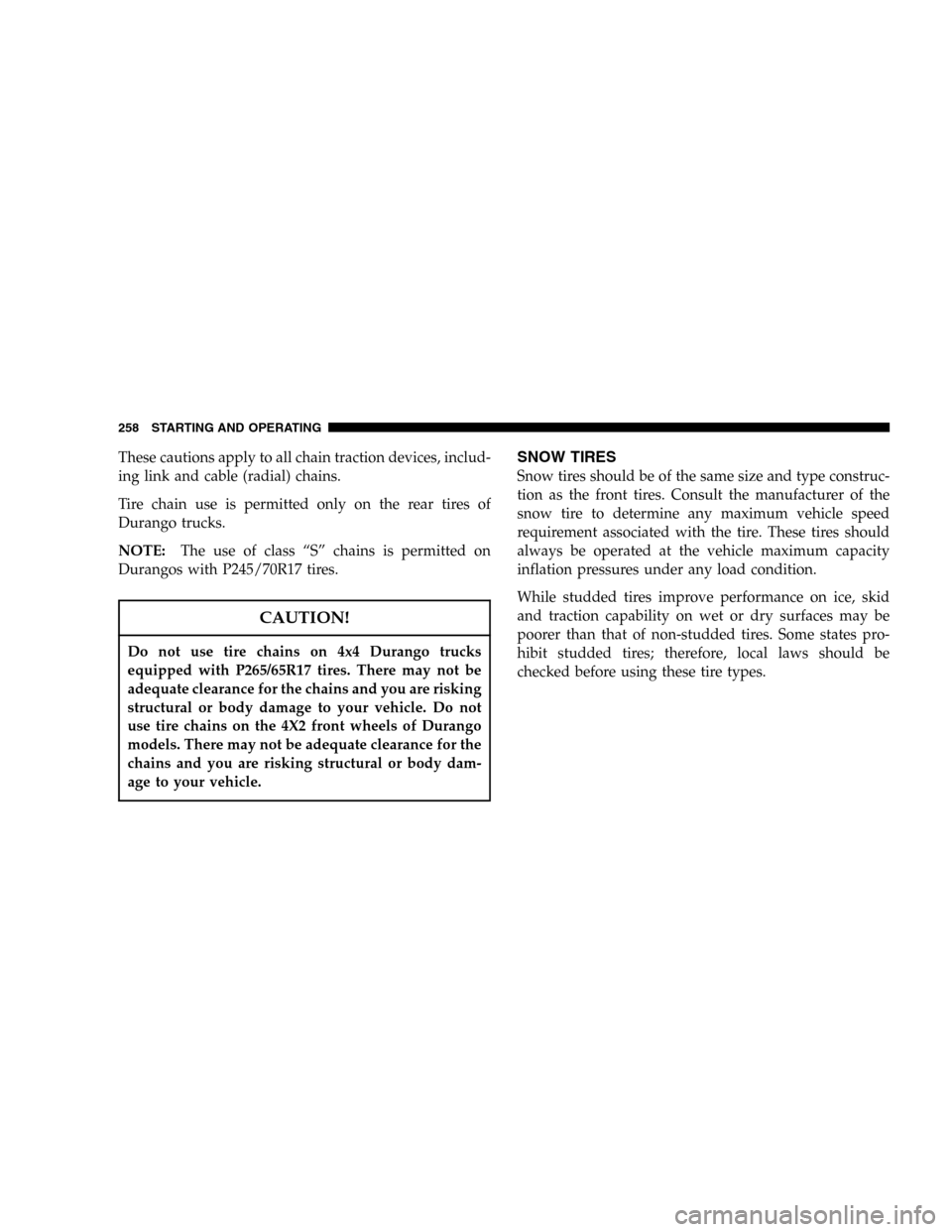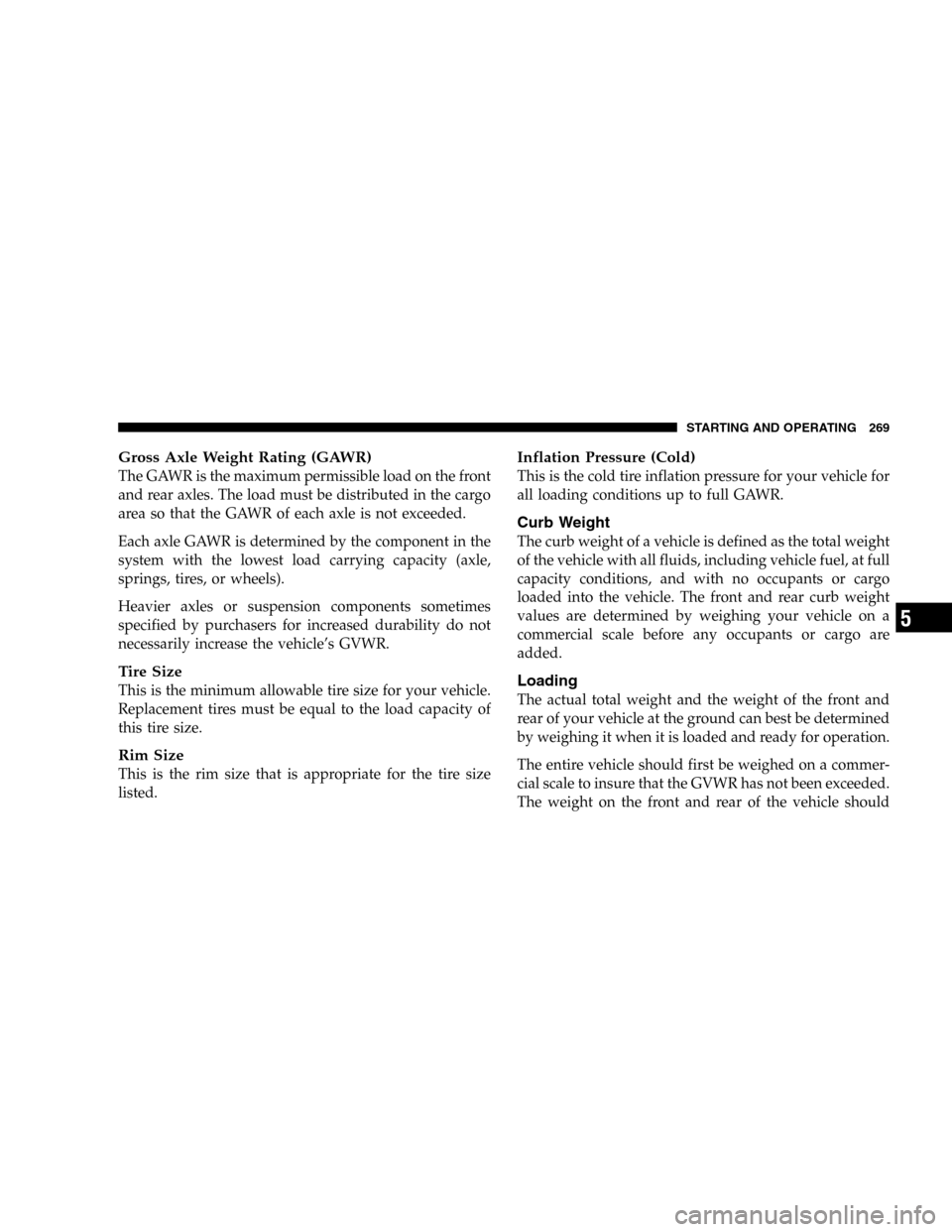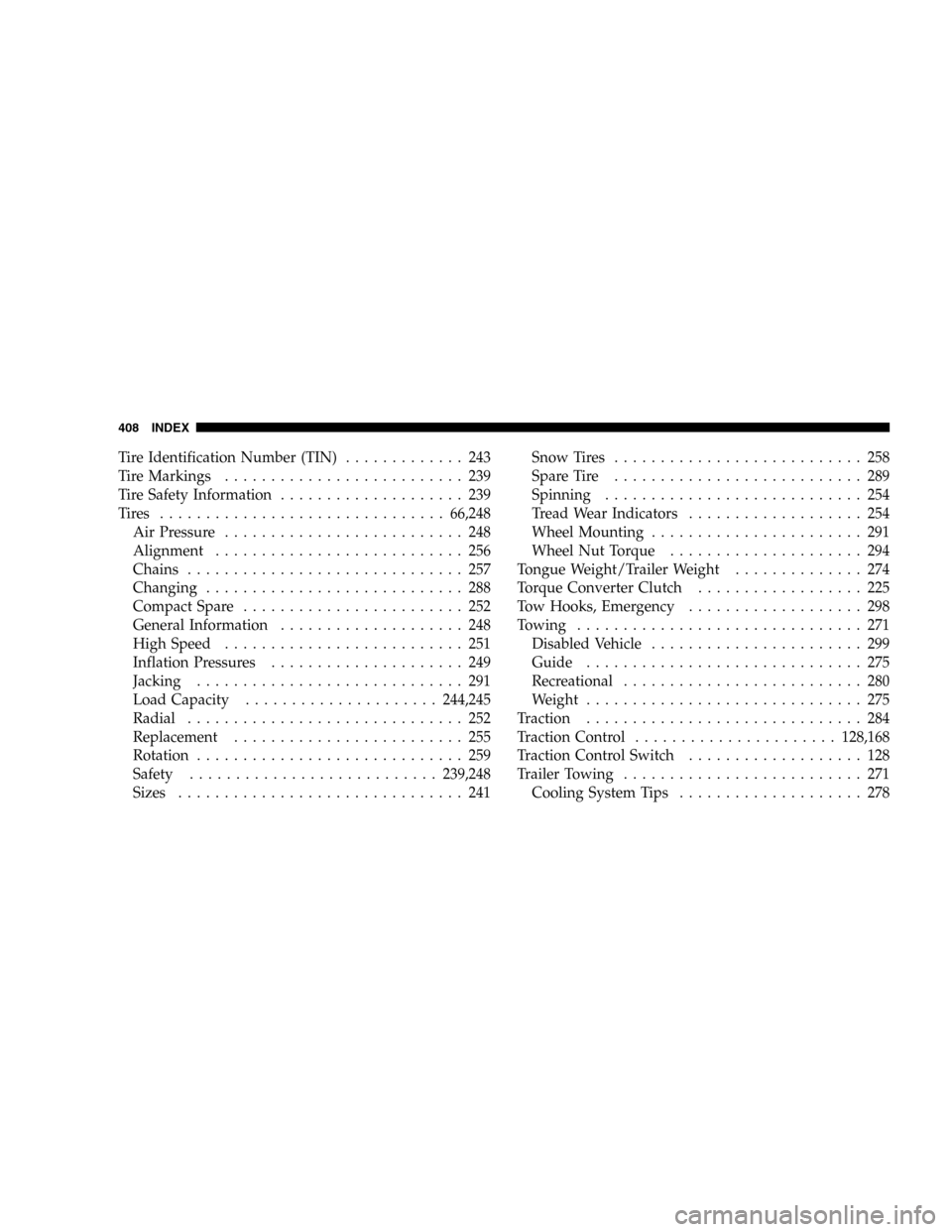tire size DODGE DURANGO 2005 2.G User Guide
[x] Cancel search | Manufacturer: DODGE, Model Year: 2005, Model line: DURANGO, Model: DODGE DURANGO 2005 2.GPages: 416, PDF Size: 14.25 MB
Page 257 of 416

Improper alignment will not cause vehicle vibration.
Vibration may be a result of tire and wheel out-of-
balance. Proper balancing will reduce vibration and
avoid tire cupping and spotty wear.
SUPPLEMENTAL TIRE PRESSURE INFORMATION
A light load vehicle condition is defined as two passen-
gers {150 lbs (68 kg) each} plus 200 lbs (91kg) of cargo.
Cold tire inflation pressures for a lightly loaded vehicle
will be found on a “Supplemental Tire Pressure Inflation”
label located on the face of the driver’s door or in the Tire
Information Pressures pamphlet in the glove box.
TIRE CHAINS
Use “Class S” chains on Durango, or other traction aids
that meet SAE Type “S” specifications.
NOTE:Chains must be the proper size for the vehicle,
as recommended by the chain manufacturer.
CAUTION!
To avoid damage to your vehicle, tires or chains, observe the
following precautions:
•Because of limited chain clearance between tires and other
suspension components, it is important that only chains in
good condition are used. Broken chains can cause serious
vehicle damage. Stop the vehicle immediately if noise occurs
that could suggest chain breakage. Remove the damaged parts
of the chain before further use.
•Install chains as tightly as possible and then retighten after
driving about 1/2 mile (0.8 km).
•Do not exceed 45 mph (72 km/h).
•Drive cautiously and avoid severe turns and large bumps,
especially with a loaded vehicle.
•Do not install tire chains on front wheels of 4x2 vehicles.
•Do not drive for a prolonged period on dry pavement.
•Observe the tire chain manufacturer’s instructions on method
of installation, operating speed, and conditions for usage.
Always use the lower suggested operating speed of the chain
manufacturer if different than the speed recommended by the
manufacturer.
STARTING AND OPERATING 257
5
Page 258 of 416

These cautions apply to all chain traction devices, includ-
ing link and cable (radial) chains.
Tire chain use is permitted only on the rear tires of
Durango trucks.
NOTE:The use of class “S” chains is permitted on
Durangos with P245/70R17 tires.
CAUTION!
Do not use tire chains on 4x4 Durango trucks
equipped with P265/65R17 tires. There may not be
adequate clearance for the chains and you are risking
structural or body damage to your vehicle. Do not
use tire chains on the 4X2 front wheels of Durango
models. There may not be adequate clearance for the
chains and you are risking structural or body dam-
age to your vehicle.
SNOW TIRES
Snow tires should be of the same size and type construc-
tion as the front tires. Consult the manufacturer of the
snow tire to determine any maximum vehicle speed
requirement associated with the tire. These tires should
always be operated at the vehicle maximum capacity
inflation pressures under any load condition.
While studded tires improve performance on ice, skid
and traction capability on wet or dry surfaces may be
poorer than that of non-studded tires. Some states pro-
hibit studded tires; therefore, local laws should be
checked before using these tire types.
258 STARTING AND OPERATING
Page 269 of 416

Gross Axle Weight Rating (GAWR)
The GAWR is the maximum permissible load on the front
and rear axles. The load must be distributed in the cargo
area so that the GAWR of each axle is not exceeded.
Each axle GAWR is determined by the component in the
system with the lowest load carrying capacity (axle,
springs, tires, or wheels).
Heavier axles or suspension components sometimes
specified by purchasers for increased durability do not
necessarily increase the vehicle’s GVWR.
Tire Size
This is the minimum allowable tire size for your vehicle.
Replacement tires must be equal to the load capacity of
this tire size.
Rim Size
This is the rim size that is appropriate for the tire size
listed.
Inflation Pressure (Cold)
This is the cold tire inflation pressure for your vehicle for
all loading conditions up to full GAWR.
Curb Weight
The curb weight of a vehicle is defined as the total weight
of the vehicle with all fluids, including vehicle fuel, at full
capacity conditions, and with no occupants or cargo
loaded into the vehicle. The front and rear curb weight
values are determined by weighing your vehicle on a
commercial scale before any occupants or cargo are
added.
Loading
The actual total weight and the weight of the front and
rear of your vehicle at the ground can best be determined
by weighing it when it is loaded and ready for operation.
The entire vehicle should first be weighed on a commer-
cial scale to insure that the GVWR has not been exceeded.
The weight on the front and rear of the vehicle should
STARTING AND OPERATING 269
5
Page 408 of 416

Tire Identification Number (TIN)............. 243
Tire Markings.......................... 239
Tire Safety Information.................... 239
Tires ...............................66,248
Air Pressure.......................... 248
Alignment........................... 256
Chains.............................. 257
Changing............................ 288
Compact Spare........................ 252
General Information.................... 248
High Speed.......................... 251
Inflation Pressures..................... 249
Jacking............................. 291
Load Capacity.....................244,245
Radial.............................. 252
Replacement......................... 255
Rotation............................. 259
Safety...........................239,248
Sizes............................... 241Snow Tires........................... 258
Spare Tire........................... 289
Spinning............................ 254
Tread Wear Indicators................... 254
Wheel Mounting....................... 291
Wheel Nut Torque..................... 294
Tongue Weight/Trailer Weight.............. 274
Torque Converter Clutch.................. 225
Tow Hooks, Emergency................... 298
Towing............................... 271
Disabled Vehicle....................... 299
Guide.............................. 275
Recreational.......................... 280
Weight.............................. 275
Traction.............................. 284
Traction Control......................128,168
Traction Control Switch................... 128
Trailer Towing.......................... 271
Cooling System Tips.................... 278
408 INDEX